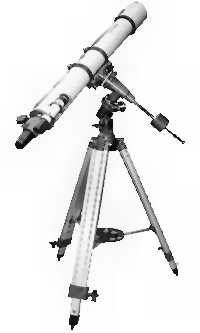 Deutsch Deutsch |
Astronomy |
 Motivation MotivationMy first interest to astronomy awaked, when I watched the starlit sky during a vacation in southern France. I discovered a small light spot, which moved slowly across the sky. At that time I thought it was a satellite, today I know, that it was a highly flying airplane. In 1997 I bought a used telephoto lens with 19,7" (500 mm) of focal length. Very fast I noticed that even for observing the moon a sturdy tripod is necessary. Desires Therefore I decided to buy a commercial telescope. But the selection of that telescope was not easy. If you follow the advertisement, then you shall buy a telescope as a "lifelong companion". The ridiculous price of these devices is probably justified by this statement. The brochures, with photographs of extragalactic nebulas, wake desires, which can be hardly fulfilled hardly? by the equipment of a hobby astronomer. In a book "fundamentals for the hobby astronomer" I found in addition the quotation: If one really buys a lifelong telescope, why do you have such a large market in used devices? I therefore searched for a compromise concerning weight, observation possibilities and investment volumes. Finally clear nights are rare and light pollution is widespread in the Rhine Main area. Equipment In defiance of all doubts I decided on a refractor (focussing is done by lens and not by mirror) with a apochromatic objective (= colour corrected lens, minimized chromatic aberration), an aperture of 4" (90mm) and a focal length of 40" (1000 mm). Since I wanted to use the instrument for sky observations, the tripod must be stable with an equatorial mount. The last item has the advantage, that only one axis must be changed, when you want to follow the apparent movement of stars, caused by the rotation of earth. Such an instrument has an average spatial resolution uand you are able to observe planets and to recognize smaller structures on the lunar surface. First observations My first view through the telescope proved the fact, that there are substantially more stars, than I could observe with the naked eye. When I directed the telescope toward the moon first, I was overwhelmed by the recognizable details. When I visited an observatory, I learned, that astronomers do not longer observe by eye but use a camera. Long exposure times achieve a higher sensitivity than the human eye. A further argument for photography is not only to communicate but to show your observation results to friends. My mirror reflex camera combined with a variable adapter, and a light-sensitive film met the basic requirements for my first moon photos. My experiences Limited turbulence of air and a telescope adapted to the ambient temperature is needed to get sharp pictures. Oscillations at the tripod and the attached telescope are caused by the movement of mirror in the reflex camera, whereby blur pictures are achieved. By using the hat method you can get rid of the last mentioned problems. The loss of light produced by the V-block of my camera is very large. While looking through the camera, I was not able to focus or even to discover faint objects, which I could recognize very well by the eyepiece. Using middle enlargements, it is impossible to mount the camera to the telescope after you have focused a stellar object with the eyepiece. At present there is no other solution but to provide a CCD camera with sufficient high resolution. In this case you even have the advantage of storing the pictures on a computer's hard disk with follow-up digital image processing. |
|
| Copyright by Hans Joachim Ilgen since 1950 | |